Menus
- 1700 cm3, 80 hp, 138 Nm of torque, cruise control, GPS, audio, € 27,850
- A test over almost 4,000 kilometers from Paris to Porto via Wheels & Waves and Bardenas
- Discovery
- In the saddle
- In the city
- On motorways and main roads
- On departmental
- Under the rain
- Off-road
- Part-cycle
- Brakes
- Comfort and duo
- Autonomy
- Practical aspects
- Conclusion
1700 cm3, 80 hp, 138 Nm of torque, cruise control, GPS, audio, € 27,850
A test over almost 4,000 kilometers from Paris to Porto via Wheels & Waves and Bardenas
Boulogne-Billancourt (France), 1974. The engineers of what was still the RNUR (Regie Nationale des Usines Renault) lay the ultimate fund for the future manager: the Renault 16 TX. With its central locking of the doors, its electric windows at the front, its retractable seat belts, its laminated windshield, its optional air conditioning, its powerful 1647 cm3 engine of 93 hp coupled to a 5-speed gearbox. reports, its corduroy bench, its Gordini-style rims, the 16 TX has everything to make people dream in these new housing estates which are mushrooming all over peripheral France. Above all, the Renault 16 TX is distinguished by its grille with 4 square headlights housing powerful iodine headlamps. Subliminal message to those who see it tumbling down in their mirrors: throw yourself on the side, peasants, to let this vessel of the road pass by a young dynamic executive !
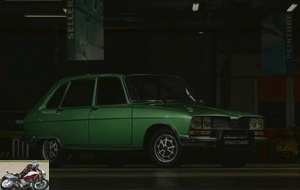
Milwaukee (Wisconsin, USA), 1979. MoCo engineers, captivated by the audacity of French genius, took four years to recover from this stylistic tsunami. They nevertheless integrate all the substance by presenting a new model in their Touring range: the Tour Glide. The Tour Glide complements the Electra Glide by being differentiated by two elements: the fairing, massive, no longer rests on the front axle, but is part of the machine’s casing by being attached to the frame. And above all, the two big "Seizeteixian" optics are emerging. They divide, the aesthetics of the whole are talking, the fold of the fairing above the optics earned it the nickname of "shark nose" (we were at the time in the teeth of the sea -mania, with the first film released in 1975 and the second in 1978).
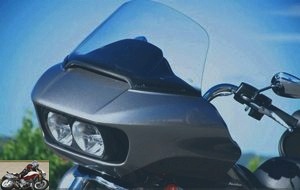
Two clans are formed between worshipers and refractories, rumor has it that some have come to blows and that marriages have been shattered. It doesn’t matter, because with the Tour Glide, Harley is extending its offer to the Touring range, its most promising market segment in its domestic market. Produced in 19 copies in 1979 and 4480 units in 1980, the Tour Glide is powered by the Shovelhead 1340 cm3 (89 x 108 mm) block mounted flexible in the frame and connected to a 5 box and a final transmission by chain positioned in a waterproof housing. The Tour Glide then evolved in detail, adopting the Evolution engine in 1984, a belt transmission in 1985 and the radio in 1986. About fifteen sidecars were assembled at the factory during the 1989 vintage out of the 603 units. produced that year and production of the Tour Glide ceased in 1996, when electronic fuel injection was introduced..
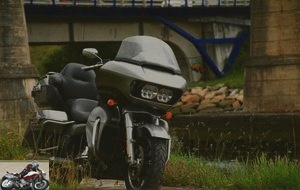
At this point in the story, you could legitimately ask yourself two questions: One, what’s the point of mounting a fairing on the frame when the Electra Glide was already doing the job in the Touring lineup? Two, am I not supposed to read an article about a Road Glide and the guy on the keyboard tells us about Tour Glide. WTF, dude !
Here are the answers to these two questions whose common sense is matched only by their clarity. Compared to an Electra and its fork-mounted fairing, the Tour Glide allowed for maximum protection while relieving strain on the front end, which improves both agility and stability. Even so, and this is no offense to them, the Harley-Davidson chassis of the time were not known for their precision and their dynamic qualities. Then, after a year 1997 without a "shark nose", it reappeared in the catalog in 1998, but this time under the name of Road Glide. For those who speak Milwaukee in the text, the parentage is obvious: the internal code of the Tour Glide was FLT, that of the Road Glide is FLTR. CQFD.
The Road Glide, however, was not always part of the range sold in France. As before, the Road Glide uses the frame and engine of the Electra Glide. As always, the evolutions took place in detail, evolution without revolution, in short. In order: appearance of the Twin Cam 1450 engine in 1999, variation in CVO versions in 2000 and 2001, switch from cassette player to CD in 2004 then to Harman / Kardon audio in 2006, arrival of the 1584 engine injected in 2007 with its 6 gearbox, Brembo brakes and by-wire accelerator in 2008, new frame with 180 mm tire at the rear and 17-inch front wheel at the front in 2009, a 2-in-1 exhaust for 2010 (and only that year) and optional cruise control that same year.
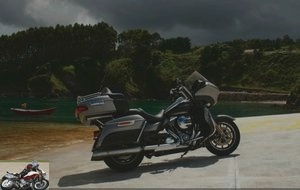
In 2014, the Road Glide even disappeared from the Harley-Davidson catalog, only to return better in 2015, with all the improvements related to the "Rushmore project", which features both a new infotainment system with touchscreen as well as modifications to the chassis, without forgetting the appearance of liquid-cooled cylinder heads with a circuit which passes in particular around the exhaust valves. Always so recognizable, the fairing nose is mounted a little further back so that the rider can have better access to the touchscreen. For Harley, this comeback was obvious: part of its clientele is made up of Road Glide fans and loyalists, and they are among the brand’s biggest riders..
In France, Harley-Davidson offers the Road Glide Special (€ 26,350) and the Road Glide Utra (€ 27,850). It would be reductive to consider the Ultra as a Special equipped with the touring attributes of the top case, high screen and leg guards, the removal of these features saving a whopping 37 kilos. The differences are deeper, with a 19-inch front wheel (fitted with a generous 130/60, instead of the 17-inch on the Ultra) and different surface treatments (the engine is in black & chrome, the lights are inserted in the turn signals …). In this sense, the Road Glide Special is intended to be a little more funky (and a bit in the spirit of a Street Glide), as evidenced by the available color palette, which notably incorporates a daring golden yellow with flames and glitter. . Let’s dare !
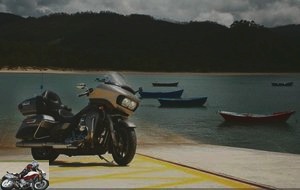
We put this Road Glide Ultra to the test on a full (and dense!) Test, over more than 3,500 kilometers and in very varied conditions, between Paris and Porto, via Wheels & Waves, the north coast of Spain and the Bardenas desert. A hell of a trip in good company, tailor-made for a machine of this ilk !
Discovery
More than 35 years after its release, the “shark nose” style still divides. Some like, like the author of these lines, others don’t, there is nothing we can do about it. The novelty, on the other hand, comes from the technology of the headlights: called Dual Daymaker Reflector LED in the language of the manufacturer, these LED lights give the machine a sacred presence with their beam of white light as soon as they are switched on. Same thing at the rear with a string of LEDs along the top case, permanently lit and even more so when braking.
The Road Glide Ultra is impressive. Long, high, wide, it can impress with the width of its fairing and the generosity of its luggage. Just looking at it, you suspect it is heavy and you shudder to learn that it weighs 407 kilograms dry and 424 in running order. Do you need a heavy vehicle license ?

Let’s continue the owner’s tour until we find the courage to get on board. Nothing to say about the quality of the painting, deep as it should be and with beautiful reflections; not more than on the quality of finish, nor that of the chrome, which fans of any beautiful Harley not "dark custom" are entitled to expect. As for the semi-liquid cooling, it is almost invisible and the fans are well integrated in the lower fairing..
The commodos impress with the number of functions available. In use, we will realize that they are in fact very ergonomic and that the small buttons at their base provide easy navigation in the menus. Ditto for the management of cruise control, radio and sound management, as well as the iPod connected through a USB socket in the right storage compartment. The 16.5 cm diameter touch screen is readable (and its lighting changes according to the outside brightness and adjusts quickly when passing through a tunnel, for example) and easy to handle. Finally, there is even a voice command for all functions…
A large number of automobiles cannot boast of such a level of equipment. !
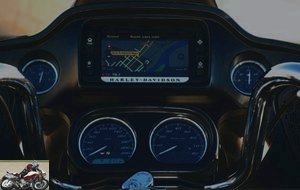
In the saddle
Shouldn’t we rename this section "sofa"? Because very thick and equipped with generous beads, the saddle alone is an incentive for long-distance travel. The saddle, what am I saying, the sofa, is quite low: 699 mm, which goes hand in hand with a rather thin tank in its front section, this to facilitate the grip. Another good news: if the weight is significant, the center of gravity is quite low like on any big custom, somewhere between the crankshaft and the gearbox. However, do not underestimate the weight of the touring fittings.
Compared to the Road Glide Special, the Ultra has a handlebars 6 centimeters higher, for a more relaxed riding position. As we have said, the controls fall well in hand and the controls, well supplied, do not require a long period of acclimatization so that we can get the best out of all the functions. As on all Harleys (except the Street 750), the ignition key is actually a transponder that you keep in your pocket. It only serves to lock the suitcases, the fuel tank and the steering. In this regard, the contactor remained in our hand during an attempt to unblock the steering, at the start of the trip, in Biarritz. Lonely moment in the hotel parking lot, with a vacant "hole" in the steering column, a spring sticking out, this thing in my hand and the steering locked. It seems that this rarely happens; a makeshift DIY made it possible to continue the journey.
Contact. Starter. Jerking! The big V2 long stroke (76.2 x 101.6 mm) of 1687 cm3 (103.1 ci) snorts and holds its idle at around 1000 rpm in nice vibrations. The handlebars and mirrors are gripped by the scrapie: that’s part of the charm, because the engine, in this version without balancing shaft, is mounted flexibly in the frame. The vibrations disappear as soon as you are in motion and reveals one of its outstanding qualities: great flexibility from the lowest revs.
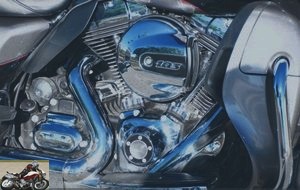
Now is the time to remove the kickstand. In view of the weight of the machine, we will take great care to wedge it with his legs. And when you put the stand back on, you won’t be surprised to see that the bike moves forward a little: it is a security that allows the bike to stall. Disturbing, then reassuring !
In the city
Some will be intimidated at the prospect of going to face the urban chaos on the handlebars of such a liner. However, without denying its weight and volume, the Road Glide Ultra does quite well from the exercise once you have it in hand. And thanks to a few qualities: first, the extreme smoothness and dosability of its clutch and accelerator controls. The by-wire is remarkably smooth and progressive and helps to manage millimeter progressions. Then, the Road Glide benefits from excellent self-stability: rather than trying to fight against its weight, on the contrary, you must put both feet on the steps as quickly as possible and play with your balance on the handlebars. and by a few sensual movements of the hips: thus, the mass becomes tamed.
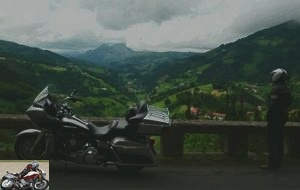
Flexibility and length: the 1700 is a good ally. It does not knock all the way down and allows you to cruiser on the boulevards at 50 km / h, at 1500 rpm in third, or even a little less in fourth, while being gentle on the gas.
If it is wide, the Road Glide Ultra is nevertheless well proportioned and nothing sticks out, suddenly, you can consider going wandering in small fishing ports without risking you to get caught on a dick..
A few days of use in Paris (it is true at the end of Road Trip, once the machine is well in hand) did not turn out to be nightmarish. With one caveat, however: the heat given off by the engine. Before Harley Big Twins switched to mixed cooling (as on the latest generations of BMW 1200 flat twins, the cylinder heads are water-cooled), these machines were hell in the city in the summer for the calories they released (or an ode to Malthusianism, by baking your gonads, which were placed just above the engine!). Obviously, mixed cooling helps to improve things and the heat wave is less sustained than before..

Harley-Davidson provides an answer to the problem with the EITMS. So what is EITMS, you have to ask yourself? It’s very simple: it’s the Engine Idle Temperature Management Strategy, in other words, a rear cylinder deactivation system, which benefits depending on the circumstances either from one ignition out of two, or not at all, just a gasoline supply. The system is useful during parades which bikers love and which immobilize the motorcycle for a long time at speeds close to idle. The management "one cycle in two" is managed automatically (we realize this with a little jerk when the gas resumes); the one which fully couples the ignition of the cylinder is decided on the handlebars (you have to push the accelerator grip forward for 3 seconds and the cruise control indicator light then comes on). I can’t really say I felt the temperature drop, while waiting at the traffic light on the handlebars of a vibrant 845cc single-cylinder Harley struck me as quite anti-mechanical. But according to Harley, it works, so…
One last appreciable thing in an urban environment: powerful and easy-to-dose braking.
On motorways and main roads
Finally, here is the Road Glide Ultra in its natural habitat: let’s not forget that it was designed first and foremost to cruiser tirelessly on straight interstates at 90/100 km / h cruising, with the main objective of providing total comfort. . On the European road and motorway network, overall more challenging than in the US (if only by the average speeds maintained), the Road Glide Ultra not only does not deserve, but brilliantly reveals the full extent of its talent..
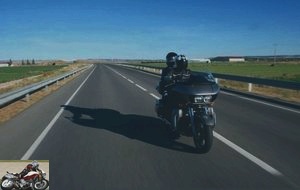
Moreover, the Road Glide Ultra allowed me (after 30 years of riding!) To live a new experience: to have mosquitoes stuck inside the helmet screen! During a descent in Biarritz on the motorway between Paris and Bordeaux, I stayed on the regulator (which operates from 90 to 140 km / h on the 3 upper gears) at the legal speed (3100 rpm in 6th gear), screen open headphones despite my large size (1.89 m) and listening to the radio, because the sound (100W) is sufficiently good and powerful and above all, the RDS function works very well. There was a beautiful evening light when we arrived in the Landes. The suspensions are silky and the sofa did its job, I arrived without pain or stiffness, fresh, available and cultivated (thank you France Inter). This is the spirit of cruising.
The generous fairing has many vents: one at the base of the windshield, two around the optics, two others at the calves. They are activated by push buttons (quite hard and not easy to handle while driving, moreover) and I preferred to keep the top 3 in the open position, in order to have a small depression which reduces turbulence. Closed, they generate a draft … On the other hand, let’s salute the aero work resulting from long hours of testing (Harley has a wind tunnel in Wichita, Kansas), because even in the rain with these vents open, we remain relatively dry.
In terms of practicality, the two storage compartments located in the reinforcement of the fairing allow toll tickets or a wallet to be glued. The 133 liters of luggage was enough for 10 days of travel for two and an extra camera bag, all without having to use the luggage rack on the top case. Royal.
At legal speeds, the Road Glide Ultra does not pose any problem of stability and we can let it go to the cruise control, putting it back online if necessary for a small counter-steering effect with the little finger. Easy. On the other hand, heavily loaded and in large curves approached at 130/140 km / h, it can start to waddle a little. Nothing abnormal: so much mass on flexible suspensions, it generates a little oscillations. But on this criterion, the frame of the Road Glide like that of the other Touring models is a bit below that, in aluminum, of the Indian and Victory competitors. This journalist’s remark being made, will a touring motorcycle customer make his choice on handling in large curves above 140 km / h? ?
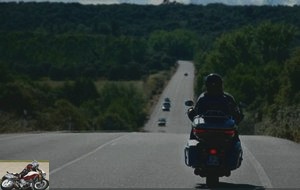
On departmental
It was not designed for that and there too, it is doing with honors, provided that you understand its philosophy and follow a few rules. That being said, there are many reasons to rejoice..
First, the engine. As we have said, supple and smooth from the lowest revs, it accepts to resume smoothly in sixth from 70 km / h (even in duo and loaded) and only turns at 2200 rpm in 6th at 90 km / h. In short, for the quiet ride, the big V2 is an ally of choice, rather placid but always present and perfectly consistent with the rest of the machine. By insisting a little, we discover a very nice effect, close to that of an old-style double-barrel carburetor, past 3200 rpm, regime where the V2 starts to push with more vigor, whereas it had already treated the intensity of his breathing some 700 rpm earlier. The 103 Ci then pushes up to 5000 rpm. Harley-Davidson does not communicate on the power of its machine, an almost anecdotal notion for a touring, but American magazines have passed the Road Glide to the dyno: results, 79 horsepower at 5200 rpm with a red zone at 5500.

The Road Glide has a ground clearance of 125 mm and a tilt capacity of 31.8 °. It is less "put on the ground" than other American machines and, on departmental roads, reveals astonishing capacities. Certainly, driving like a road rally is to be avoided, but by winding with the way, you do not drag yourself, even if after a while, the limits of the ground clearance are reached (footrest plate on the right , as well as on the left, side where, it is more annoying, the rear exhaust elbow also comes to rest on the road).
Knowing that the coupled braking is good, it still gives reasons to keep the banana in the shade of the chestnut trees. This all the more so as the number 1 argument of the Road Glide is full of truth: thanks to the fairing attached to the frame, its front end remains neutral, does not weigh, does not widen and allows to maintain, in flexibility, the trajectory. chosen. In this exercise, it is actually less heavy than an Electra Glide or even an Indian Roadmaster.
The only limits inevitably come when the mass begins to waddle: a succession of moderately fast curves (110/120 km / h), the motorcycle loaded, an irregular asphalt and, on the handlebars, we start to ride with a little less margin. But that is not his vocation…
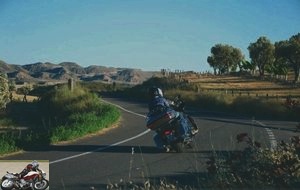
Under the rain
This long-term test having been abundantly watered, driving in the rain brought out excellent news, not very good news and a small surprise..
Excellent news: As a ship of the road, the Road Glide Ultra knows how to preserve its crew. Pilot and passenger were never really wet, the upper and lower fairings doing their job remarkably; same comment with the absence of turbulence or eddies returning from the back which could have wet the passenger’s hair. This makes it possible to arrive in shape in the evening at the stage, even after several hours of driving in the rain and not having to share the subtle smells of wet socks or boots as was the case with my comrades….
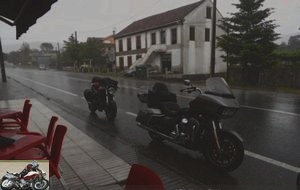
Little surprise: the curvature of the windshield releases a small iridescent effect at its base. At the start, you arrive in the bends with the impression of having diesel in front of you. Not reassuring, but we end up getting used to it by opening our nostrils…
Not so good news: the very average grip of the Dunlop D408f tires. Already, the feeling is not extraordinary (not to say that it is in fact non-existent) in the big curves approached under the deluge … but the very square profile of the rear tire makes it sensitive to small inclinations, like exit roundabout, where the big couple asks only to make you drift with a gas stroke in second. Distrust, therefore … Even if a tire cannot do everything, we also understand that given the target and uses in the USA, we first asked the tire for comfort, stability and mileage, in sacrificing grip in the wet.
In short, with a Road Glide Ultra, we still lower the pace of driving in the rain by a big notch..
Two more good news to conclude this chapter: the smoothness of the controls and the engine are real allies in helping to overcome these difficult conditions. And the luggage is perfectly waterproof.
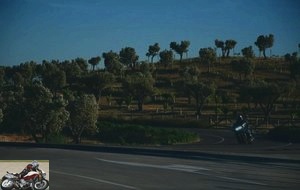
Off-road
An off-road section devoted to a touring motorcycle weighing more than 400 kilos? Yes ! First, because America is the country of the great outdoors and going to touch a glowing sunset that plunges into the horizon should not remain just a fantasy..

On a rolling track (not in Nevada, but in the Bardenas), the Road Glide has once again shown that its balance allows it to overcome difficult situations. Of course, you have to anticipate, but by gently winding in 3 or 4, avoiding potholes and big breaks, they played the event with talent..
And it’s beautiful, a desert, in the evening…
And it lights up really well, a Road Glide UItra in the dark…
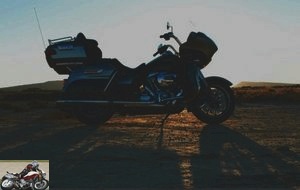
Part-cycle
At the turn of the 2010s, Harley-Davidson revised the chassis of its touring range by making it more rigid and the handling was improved. On the Road Glide Ultra, we find a solid fork with 49 mm in diameter and 101 mm of travel, while a double shock absorber takes care of the rear. On this test, different passengers (even a large passenger with a large Nikon) boarded and, depending on the total mass, certain balances may be upset. Nothing dramatic since the rear shocks are pneumatically adjustable. Only downside: Harley sells the pump as an option. To punish them for this forgetfulness, we will find similar ones on the net, necessarily cheaper..
On the tire side, the Road Glide Ultra is mounted on 130/80 x 17 at the front and 180/65 x 16 at the rear. Nothing that is not "oversized", for the benefit of neutrality of behavior.
Brakes
Harley-Davidson have long had a bad reputation on this point and given the mass of the machine, we could start with a bad a priori.
In this case, perceptions die hard because the Road Glide brakes well! The system is entrusted to 3 discs of 300 mm, all clamped by Brembo 4 piston calipers. The ABS is rather efficient and especially the coupled braking (active from 30 km / h) is effective, as soon as we understand that it is the brake pedal that will provide most of the effort..
Again, this all depends on your understanding of the weight and philosophy of the machine, but throughout this test I haven’t had a single scare from the braking, although it may have occasionally started. to feel the heat in a descent of the pass.
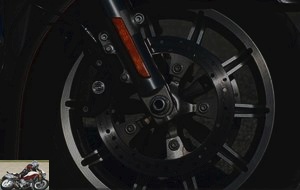
Comfort and duo
There, it’s simple: it’s a palace. On occasion, a passenger complained about a few vibrations in the back of the seat and another asked me where the cup holder was for the mojito. Not the official passenger who found the bike remarkable and who took advantage of the long trip to recover a few hours of sleep, even during a downhill pass. Ergonomics, quality of the seat, protection of the fairing: it is 5 stars everywhere.
Without a doubt, the Road Glide Ultra is one of the best on the market. We will also appreciate the possibility for the passenger to change the volume or the radio station, thanks to two buttons on the right side.
Regulated flexible, the suspensions obviously participate in the harmony of the whole. Just like the sound of the original exhaust: present, pleasant, but not intrusive.
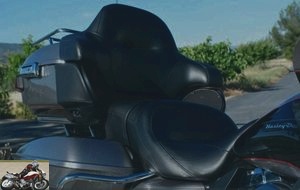
Autonomy
The tank holds 22.7 liters; it is doubled by a fuel gauge and an autonomy indicator which are extremely precise in both cases.
The good news (one more!) Is that given its mass, the Road Glide Ultra is sober: 5.5 l / 100 solo at 130 km / h on the highway and 5.2 l / 100, always solo, on the small departmental areas of the vineyard and the Landes between Bordeaux and Bayonne. Subsequently, in duo and loaded, the consumption was established between 6 and 7 l / 100 over the whole trip, with an average of 6.4 l / 100. Enough to guarantee between 350 and 400 kilometers of autonomy, which allows to fill up every two when driving in a gang.
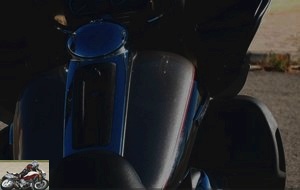
Practical aspects
Again, full box! 2 12 V sockets, a GPS, a voice command that allows you to use your Bluetooth phone®, two storage compartments, a 100 W sound system with 4 HP USB socket for a portable reader, two joysticks on the handlebars to manage it all easily. In short, it’s great.
Alas, there is no such thing as perfection. We could have required the presence of original heated grips, given the price and purpose of the machine. We could also have appreciated centrally controlled suitcases (as is the case with Indian). And the GPS, if it is effective, suffers from a few small quirks in its operation. Example: you enter an address, which takes a little time because you have to start by indicating the country. Your ecological soul makes you do this with the ignition on, but the engine stopped. But, kidding, a starter will put the infotainment back on the radio and it will take a few more manipulations to get back to GPS….
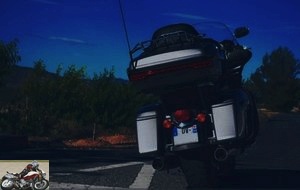
Conclusion
The customers are always right and if, in the USA, the owners of Road Glide are the biggest rollers of the mark, it is not without reason … Because this machine is a formidable devourer of kilometers, that a long test and demanding like this failed to shake. Imperial over long distance, rather easy on small roads, it is devoted only to the pleasure of the ride that sublimates the comfort of its saddle, its carrying capacity, the level of equipment and the clarity of the radio..
The weight, the volume, the dimensions can be intimidating: but the overall balance makes it rather easy to handle, once the initial apprehension has passed and a few rules have been followed, while its front axle is much lighter and more precise than that of an Electra. As for the engine, more than its power, its roundness and its torque are really appreciated over time..
Admittedly, at 27,850 €, it represents a sum, but with the exception of the Kawasaki 1700 Voyager (which will discount much faster), all its competitors are in this price range and with the exception also of the Victory, some small thousands of euros cheaper. Admittedly, its look can divide, with its headlights, its nose … But if it does not put you off, there is only one way to fully appreciate this machine: to show it the country..
Strong points
- Look !
- Smooth and pleasant motor
- Long-term travel skills
- Royal comfort
- Excellent protection
- Carrying capacity
- Efficient coupled braking
- Measured consumption, autonomy
- Sound quality
Weak points
- Heavy weight, in absolute terms
- Wet tires
- Some GPS interface details
- Heat rises in the city
- Deactivation of the slightly "mechanical" rear cylinder
- Ripples in large curve at "high" speed
- No original heated grips
The Road Glide Ultra technical sheet
Test conditions
- Itinerary: 3,900 km distributed as follows: motorway to Bordeaux and small roads to Biarritz (thanks to SNCF and CGT who canceled the auto-train!), A few days at Wheels & Waves in Biarritz, then trip to Saint- Jacques de Compostelle (E) via the northern coast of Spain, descent to Porto (Portugal), then diagonal to the Bardenas desert and return to Paris by auto-train from Biarritz.
- Motorcycle mileage: 7000 km
- Problem encountered: a contactor that seizes up but the motorcycle was able to continue to run.
Competition: Honda GoldWing, Indian Roadmaster, Kawasaki Vulcan 1700 Voyager, Victory Cross Country Tour
- All Harley-Davidson tests
- All custom tests
- All road tests
Related articles
-
Harley-Davidson Sport Glide 107 Test
Touring and sport at the same time: absolute versatility according to Harley V2, 1745 cm3, 84 hp at 5400 rpm, 145 Nm at 3250 rpm, 304 dry kilos, from €…
-
Comparo Harley-Davidson Street Glide 107 & Road Glide 107
Which model of the touring range to cut the road ? V2, 1745 cm3, around 90 hp, 150 Nm, from 376 kilos fully loaded, from 26,890 € Some manufacturers have…
-
Harley-Davidson Ultra Limited Low ‘107’ test
New Milwaukee-Eight engine with 8 valves and mixed air / water cooling for this large road accessible to all 1745 cm3, approx. 90 hp, 152 N.m at 3250…
-
Harley-Davidson CVO Street Glide Test Drive
Fantastic ride … on the spine of the eagle. Legend AND myth, this is the concept of a Harley Davidson CVO (Custom Vehicle Operations). The Milwaukee…
-
Harley-Davidson Sport Glide test
Duo test of the Softail model over 1,500km, including 700 km in one day from Camargue to Paris V2, 1745 cm3, 86 hp at 5,450 rpm, 139 Nm at 3,250 rpm, 317…
-
Harley-Davidson CVO Street Glide 114 test
V2, 1868 cm3, around 100 hp, 165 Nm, 398 kilos with full fuel, € 39,550 A certain vision of the exception made in Milwaukee and a really punchy 114…
-
Harley-Davidson Road King Special test
V2, 1745 cm3, approx. 90 hp at 5500 rpm, 150 Nm at 3250 rpm, 355 kilos dry, from € 25,390 The Dark Custom spirit touches the queen of the road Discreet…
-
Harley-Davidson Road Glide CVO 117 test
Welcome to excess Harley-Davidson V2, 1923 cm3, 105 hp at 5450 rpm, 166 Nm at 3500 rpm, 385 kilos dry, from € 41,290 From when, too much is enough? What…
-
Harley-Davidson CVO Road King test
Classic luxury bagger An essential bagger of the American brand, the Road King is available this year in a CVO (Custom Vehicle Operation) version,…
-
200 hp at 13,500 rpm, 112 N.m at 11,500 rpm, 199 kilos with full fuel, from € 18,499 Is the Crossplane engine an advantage in road use ? Even if the…
Menus
The Sicilian Clan
Pirelli invited us for a “life-size” test on the small roads of Sicily with the Scorpion Trail. Three years after its presentation, the first Pirelli bigomme trail tire has undergone a slight technical development which has given us the opportunity to get to know it better on Sicilian asphalt..
"Times change, the automobile too"…. Fiat wrote on the rear window of his 128…. in 1969. Imagined more than 40 years ago, this advertising slogan applies just as much to motorcycles. As history is an eternal restart, on motorbikes as elsewhere, we can see in a certain form a return to basics. Derived from road bikes, the first trails, called "scrambler" were just good to make a few escapades off asphalt…. A bit like the machines we are offered today: BMW 1200 GS, Ducati Multistrada, Guzzi Stelvio, or Yamaha Super Tenere, etc. which weigh between 250 and 300 kg with full fuel.
But before arriving at these monsters and between these two periods spaced about fifty years apart, there were the first real light trails: Yamaha DT then XT, Suzuki TS then DR, Kawasaki KE then KLR / KLX or even Honda SL, then XL, XLS, XLR to name just the four Japanese. Machines that had real off-road inclinations and for which the equipment of nipple tires was essential, even if the only jumps they made were often sidewalks…. Under the influence of the Paris Dakar, they were given big tanks, big suspensions, big engines and often one more cylinder. As a consequence of this bulimia, a hundred kilos more, a hundred more horsepower too and another 100 km / h more in top speed, if one compares a Multistrada to a 500 XT. So obviously, we had to change the tires ….
To hell with pacifiers
It is in this context that Pirelli presented its Scorpion Trail 3 years ago. True to its image, the manufacturer has designed a very sporty tire! It begins with a particular drawing, called "four pitch" in English, the pattern of which is repeated only four times over the entire outline..
This very long route with triangular indentations offers great rigidity to the paving stones while taking care of water drainage. To provide a good level of grip on the corner, the water evacuation ridges are gathered towards the center and not very present at the ends of the profile.
Logically, in the rain, we won’t look for the maximum angle! In fact, by limiting them on the ends, we have more contact surface, which is good for offering maximum grip on dry ground. Also with this objective in mind, the scorpion trail is nothing more or less than a twin compound at the rear !
Finally, to give performance and even improve it during this evolution, Pirelli has used a mixture of carbon black-based gums for great stability. Another essential component on this type of tire: silica, which improves grip on cold or wet ground. Finally, the resin used is supposed to ensure good mileage longevity to this champion..
Champion is the word because the Scorpion Trail is the fastest and widest approved trail tire: 190/55 R 17 in W index, i.e. capable of supporting 270 km / h !
A real track tire !
Yes, but not necessarily the one we think of when we talk about trail running. We forget a little about the not really rigid studded tires. Even if he knows how to face the deserts (Paolo Pirozzi has completed a round the world in 100,000 km and 80 countries on a Multistrada with 8 successive Scorpion Trails trains), the scorpion trail prefers to eat asphalt.
In fact, after a test drive where we were able to appreciate its comfort, its responsiveness and its behavior in the face of enormous transverse or longitudinal drops, we went to the Pergusa autodrome to assess its grip..
Already on the road, the animal had won us over with its ease and level of grip on slippery asphalt to say the least. While the Angel ST had given a few warnings, the Scorpio went about their task without flinching. Of course, by doing it on purpose, we managed to trigger the Multistrada’s anti-slip system, but in normal driving, no problem. It was therefore confident but still a little curious that we took the fresher track of Pergusa. There is something odd about the idea of doing the circuit with a trail tire. But in fact after a few laps we see that the Scorpion and the Angel ST are quite evenly matched..
Stable and efficient
Thanks to its designs and its radial carcass at 0 ° the Scorpion stays the course in all circumstances. Stable at high speeds, it is also under braking and does not straighten up when braking on the angle. Not very sensitive to bitumen connections, it absorbs unevenness with ease and lets the rider swing the bike with ease thanks to its very progressive profile.
On the track, the horses go by without skating and you can happily take a lot of angle without asking any questions. In use, at no time do you think you are on a motorcycle with trail tires.
The shape of the drawings, the presence of the bigomme rear make us forget this vocation. In fact, when you know the efficiency of big trails on secondary roads, you think that a 1200 GS or Multistrada / Scorpion Trail tandem must be difficult to follow. This is what Pierangelo Misani, director of the R&D department confirms: "on weekends, the big game for owners of 1200 GS is to go and provoke sports cars on small roads and give them a beating". And given the way he talks about it and how he knows how to turn the throttle, I think Pierangelo is one of the provocateurs in 1200 GS, because he told us to have one….
Table of dimensions: Note that to adapt to very different machines, depending on the dimensions, the Scorpion Trail may be radial or conventional, tubeless or with chamber.
Strong points
Weak points
Dimensions table
Front tire
90/90 – 21
100/90 – 18
100/90 – 19
110/80 R 19
120/70 R 17
Rear Tire
120/90 – 17
130/80 – 17
140/80 R 17
150/70 R 17
160/60 R 17
180/55 R 17
180/55 ZR 17
190/55 ZR 17
150/70 R 18
Longevity tests and biker reviews on Pirelli tires